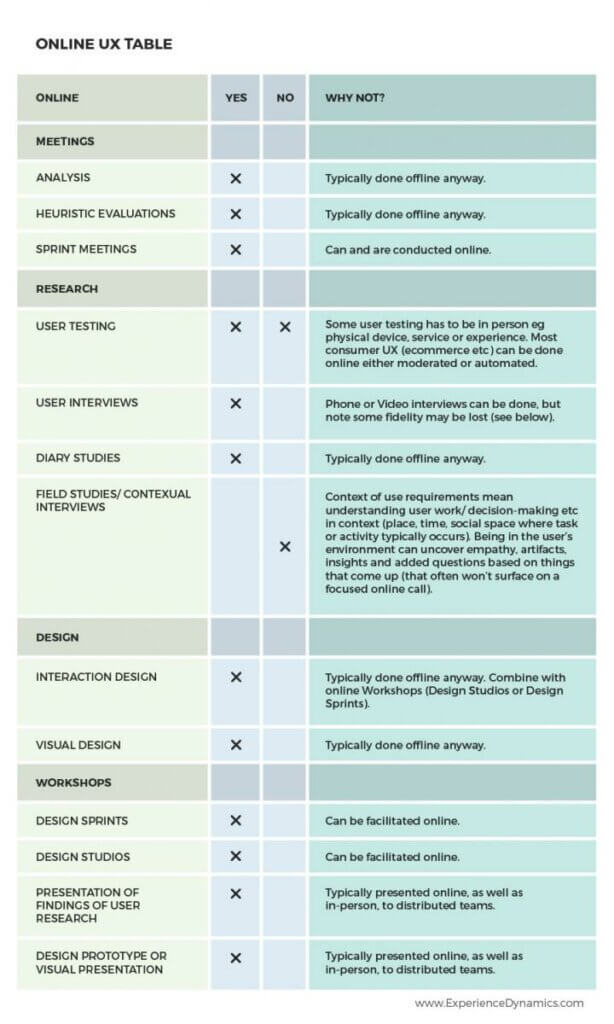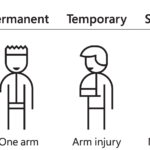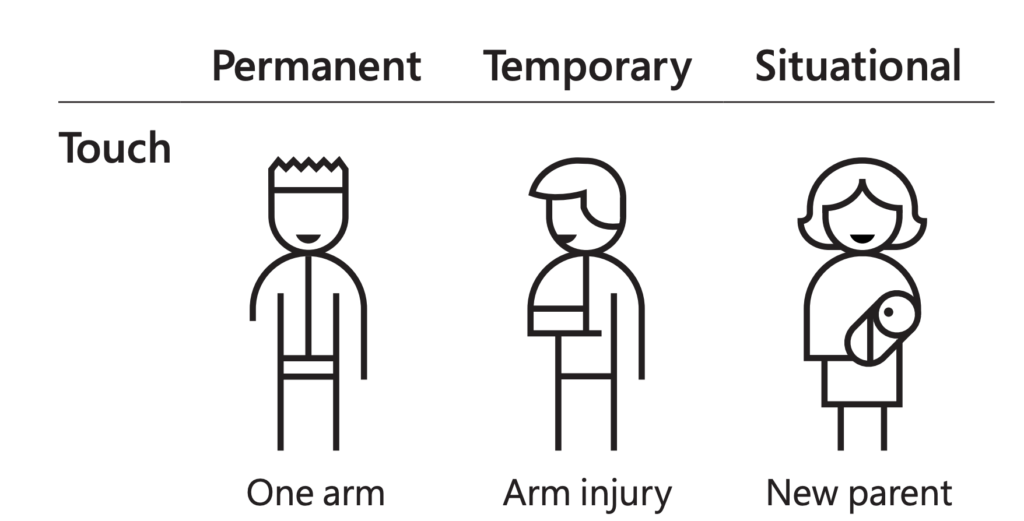Summary: Research and design activities make up the majority of UX. You can do most of your UX online. That said, you should do user research in-person whenever possible– to maximize contextually relevant insights and strengthen user advocacy. In times of pandemics like COVID-19, most UX research can be handled online. We review key UX activities and deliverables to assess online strategies for maintaining your UX process quality when online is your only option.
What can be done online, and what cannot?
The UX role (see list of roles) tends to involve meetings, research, design, and team-building presentations or workshops. You can perform the majority of these tactical activities online. Some types of user research (user testing that requires a physical product, service, or full-body experience, for example) and contextual interviews or Field Studies, which require intercepting user tasks, artifacts, and memories that are place-based, are best done in person. You can deploy Online interviews and Diary Studies in these instances.
Here’s a table that breaks this down by common activities UX Designers and UX teams engage in:

Above: Table showing common UX team tasks and showing that most can be done online, with the exception of certain types of user testing and field studies noted above.
What about Remote User Research?
Remote user research has been a staple of UX activities since at least 2005. Once you understand the pros and cons of remote research, you will find that a lot of UX can be done online.
Note: The term user research usually implies user testing, so always clarify because user research in UX includes two core activities: Field Studies and User Testing. Both are equally important at different stages of a UX design creation, but user testing is easier to do online.
Evaluating the effectiveness of types of user research done online:
1. Remote User Testing: 75% Yes; 25% No. User testing has been virtualized completely. You will find a crowded marketplace of online testing solutions, each with different pros and cons– which we will not cover (or endorse) in this article. Remote user testing is usually cheaper and easier to manage for internal teams running regular UX practices. By remote user testing, we mean a 3rd party service that facilitates the test for you. Several allow the researcher to facilitate the test, which is always preferable.
If your 3rd party user testing software allows, choose Moderated testing 80% of the time. Automated testing cuts you off from interacting with users. Automated also means less depth of examination of issues discovered, and less chance to gain empathy through that exploration. It can also make your UX team lazy (automate research vs. “getting your hands dirty” dealing with actual users).
Moderated remote usability testing is perfect for going “online” with your UX testing efforts. Even a simple web conferencing software (cheapest option) can suffice for user testing, as well as user interviews (video not essential, and can intimidate users, so get advanced consent). Online needs analysis (user interviews) can be conducted with any audience– unless it cannot.
2. Remote Field studies? 50% Yes; 50% No. We usually do not conduct user interviews online. We get better data in-person leveraging Rapid Ethnography techniques. A small number of robust online user research (Ethnography) solutions exist, contrasted with user testing which has many established solutions. It is important to realize that user interviews and non-test-based research lose the power of contextual insights when moved online. Therefore, most UX pros like to do user needs analysis in-person.
You can do user needs analysis, normally performed through field study, online with any web conferencing software, or combining that with a Diary Study (Webinar and eBook). Diaries provide self-report experience logs over a 1-2 week period. This is becoming our new default during COVID-19.
A note on recruiting: Quality user targets matter (see this post on recruiting). If you use a 3rd party user testing solution be careful of limited screening criteria. The key is to recruit people who do the thing you are studying (moot point for B2B).
Get your hands dirty when you can
A note on getting too cozy online: At Experience Dynamics, we normally recommend user interviews in-person and remote Automated user testing as an adjunct to your regular usability testing activities. It’s ultimately a quality and user advocacy issue. You want yourself and your team to be close to users (that’s right, “Get your hands dirty”). This way you get rich interaction, more empathy, and better observation, as anyone who has done this research will attest. Moreover, you get the detection of unspoken and nonverbal clues or unanticipated insights. However, during a pandemic, that’s not possible. But when the pandemic is over, you want to sustain best practice and not run on the emergency generator UX techniques. This is in spite of your boss, who wonders why you can’t remote and automate all UX research.
Remember UX research is ultimately about enriching UX Designer and team learning. It’s about good decision-making for your team and stakeholders. You’re not gathering analytics. You’re gathering understanding, story experiences and pain points.
Conclusion:
In a pandemic like COVID-19, do all user testing online, either leveraging a software solution or just using web conferencing software (even cheaper). Aspects of Field studies can be conducted online in the form of user interviews and Diary Studies. You must evaluate what you are gaining and losing. Additionally, educating your team, boss, and stakeholders and preparing to do in-person interviewing again when conditions are safe are things you should do.








